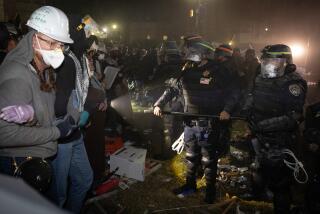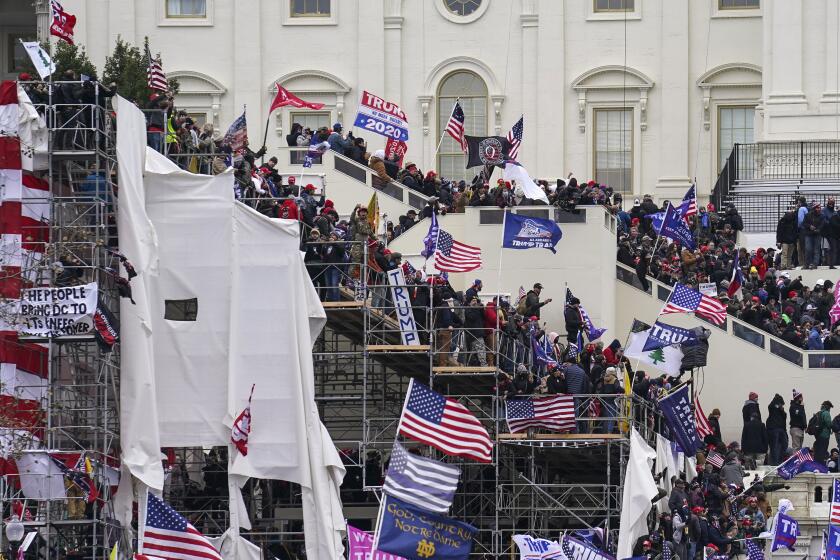Dole Video Is Images of Past and the Posed
The backdrop is a Lincoln Park ice cream social, summer twilight in the American Heartland. Bob Dole, celebrating his 73rd birthday, pounds down cups of Dairy Queen ice cream, signs autographs on dollar bills and chats with the nice African American families clustered around him at the picnic table.
Dole media director Don Sipple’s film crew catches it all: the old men in overalls, the children in rompers, the John Deere tractor, the petting zoo, the nice African Americans recruited for the cameras to sit by Dole to emphasize his “inclusive” approach to politics in a biographical video to be unveiled Thursday night at the Republican National Convention.
For the record:
12:00 a.m. Aug. 15, 1996 For the Record
Los Angeles Times Thursday August 15, 1996 Home Edition Part A Page 3 Metro Desk 2 inches; 39 words Type of Material: Correction
Clinton video--Because of an editing error, a story in Wednesday’s editions incorrectly said that Mandy Grunwald had played a major role in producing the Democrats’ “Man From Hope” convention video in 1992. The video was produced by Harry Thomason and Linda Bloodworth Thomason.
“They sat us right here,” said Natonya Cullers, 22, a Democrat and unwed mother on welfare who has no plans, she says, to vote for Dole. “It was done for the camera because we’re black.”
While that kind of engineering bothered some of Cullers’ friends, Democratic consultant Mandy Grunwald, who played a major role in producing Bill Clinton’s “Man From Hope” video four years ago, dismissed it as business as usual.
“Most of these things are engineered,” she said. “That doesn’t shock me.”
Among GOP strategists, the hope is that Dole’s videotaped life story, tightly choreographed and likely rich with nostalgia, much of it genuine, can do for the presumptive Republican presidential nominee what “The Man From Hope” film did for Clinton: reintroduce in flattering light a man the nation already knew but didn’t really like a lot.
Candidate biographical films have become a staple of convention week. On the one hand, they premiere before the most adoring of audiences: delegates of the candidates’ very own party. On the other, they are little more than unpaid ads costumed as news and broadcast, or so campaign officials hope, on prime-time network television.
“Clearly what ‘The Man From Hope’ did for Bill Clinton was, at a time when his character was under attack, it explained him in a different way, explained his roots,” said political analyst Sherry Bebitch Jeffe. In 1996, “Dole needs to humanize his image. . . . The goal is to paint him as not dour.”
While Dole is starting to see some good news in the polls, his campaign is still struggling. One reason, according to Dole, is that people don’t know Bob Dole, the man.
The big question is whether this video will help him.
Republican analyst Kevin Phillips is doubtful. He argues that the 1992 Clinton film worked because of extenuating circumstances.
“Clinton’s bio converged with a whole lot of other favorable situations--[independent candidate Ross] Perot coming out of the race [which he later rejoined], the red, white and blue-bunting bus trip through the Ohio Valley [following the convention]. He had everything breaking for him at once,” Phillips said.
Political consultant Mandy Grunwald, director of advertising for the 1992 Clinton campaign, agrees, but for a different, somewhat more partisan, reason. Dole, she said, is a “creature of Washington” whose life for more than a quarter of a century has little in it that common viewers can relate to.
“We’ll see what these guys come up with,” she said.
Sipple has been lying low, avoiding phones, so far shying away from discussion of what he has come up with.
He is best known for his positive profile pieces, and he hopes to create in this short video the image of a larger-than-life, all-American hero: Dole the wounded veteran, the solid senator, Everyman from the Midwestern wheat fields. Early plans described a video long on World War II footage and scenes of life in Russell.
The most recent footage shot by Sipple, which may or may not show up in the finished product, includes the Dole tour of Russell and the stage-crafted evening birthday party, after which the candidate spent several hours talking to residents of his hometown and its environs.
Cullers recently moved to Russell from Kansas City with her three children and fiance Greg Miller. The five were arrayed around the picnic table by Sipple’s crew, who told them they would be in a film and asked them to sign release forms. Dole asked their ages and that’s about it, Cullers said. She wished that she could have talked to him about Aid to Families With Dependent Children.
That was the subject closest to Lakisha Holloway’s heart also. Holloway, 17, is a recent Russell High graduate and one of the town’s few African Americans. This night, as she sat across from Dole, she was dangling her daughter, 8-month-old Kavasea.
“One of his volunteers came up and asked us to” sit with him, she said. “At first I didn’t think about it. . . . Just because we’re black, they wanted us here.”
Other images are more clearly true to life.
Viewers will likely see grainy black-and-white stock footage of World War II soldiers running across hilltops as bombs explode nearby, of wounded infantrymen trundled on litters.
They will likely see still photos of a uniformed Bob Dole, handsome and painfully young. Then there will be pictures of the wounded Dole in a hospital bed, shrunk to a ghost of his prewar self.
And they will likely see before-and-after photos of a homier kind: pictures of the cream station where Doran Dole, the candidate’s father, worked on Main Street. These days, it’s the Sunflower Bar, all red paint and beer signs. And they will see the family house on Maple Street; during the city’s oil boom, the hard-pressed Doles lived in the basement and rented out the upstairs.
Times staff writer Dave Lesher contributed to this story.
More to Read
Get the L.A. Times Politics newsletter
Deeply reported insights into legislation, politics and policy from Sacramento, Washington and beyond. In your inbox three times per week.
You may occasionally receive promotional content from the Los Angeles Times.







